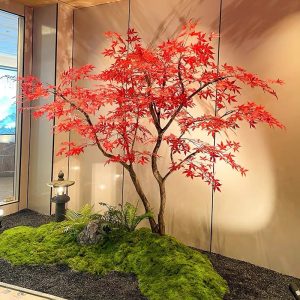As schools continue to prioritize campus aesthetics, reduce operational costs, and foster student well-being, artificial plants have emerged as a valuable addition to educational environments. Offering low-maintenance, long-lasting, and cost-effective solutions, synthetic greenery helps create vibrant, welcoming spaces while serving practical purposes. This article explores the ways in which artificial plants can improve school settings, providing both aesthetic and psychological benefits, and offers guidance on selecting the best plants for various school spaces.
1. Practical Benefits of Artificial Plants in Schools
Artificial plants are widely utilized in diverse areas within schools, including classrooms, libraries, hallways, reception areas, and cafeterias. These plants not only serve as decorative elements but also offer several practical advantages.
1.1 Enhancing the Visual Appeal of School Spaces
One of the most notable advantages of artificial plants is their ability to introduce greenery into indoor spaces without the need for sunlight, regular watering, or constant upkeep. According to a 2020 study by the American Society of Horticultural Science, incorporating greenery into indoor spaces can increase perceived attractiveness by up to 23%. Unlike live plants, which require continuous care, artificial plants maintain their fresh, vibrant appearance year-round, contributing to a visually appealing atmosphere in schools.

1.2 Cost-Effective Maintenance
Live plants come with recurring expenses for watering, fertilizing, pest control, and seasonal upkeep. A 2022 study by Statista found that the average school spends approximately $1,200 annually on plant care. In contrast, artificial plants require minimal maintenance, are unaffected by weather conditions, and can last for many years. This makes them a more cost-effective long-term solution, significantly reducing maintenance costs while maintaining a consistent aesthetic.
1.3 Psychological Benefits for Students
Environmental psychology research indicates that plants—whether real or artificial—positively influence mental well-being. A 2019 study published in the Journal of Environmental Psychology found that students in classrooms with plants could concentrate 25% longer than those in environments without plants. The presence of greenery has been associated with reduced stress, improved focus, and a more positive mood, contributing to a better learning environment.(National Library of Medicine)
2. Psychological and Educational Impact of Artificial Plants
The physical environment in which students learn plays a crucial role in their mental health, academic performance, and emotional stability. Artificial plants contribute to creating a positive, calming atmosphere that supports both academic focus and emotional well-being.
2.1 Improving Concentration and Cognitive Performance
Numerous studies have demonstrated that plants enhance concentration and cognitive performance. For example, a 2021 study by the Cognitive Science Journal found that exposure to natural elements like plants increased students’ cognitive performance by 12%. By incorporating artificial plants into classrooms, schools can replicate these benefits. Even synthetic greenery helps reduce mental fatigue and boost focus, creating an optimal learning environment.
2.2 Reducing Anxiety and Promoting Emotional Stability
The calming effects of plants are well-documented. A 2020 study by the University of Queensland found that the presence of plants reduced anxiety levels by 15% in indoor settings. Artificial plants offer the same emotional benefits as live plants, especially in environments with limited natural light or conditions that are unsuitable for live plants. Their presence helps create a balanced and soothing atmosphere, which is especially important in high-stress areas like classrooms.(National Library of Medicine)

3. Case Studies: Real-World Examples of Artificial Plants in Schools
Here are two examples demonstrating the positive impact of artificial plants in school settings:
3.1 Case Study: High School Library
A public high school introduced artificial trees and ivy vines into its library and student lounge. As a result, students spent 15% more time in the library. Additionally, the school saved 30% on its green space maintenance budget due to the low-maintenance nature of synthetic plants. Source: National Education Association.
3.2 Case Study: International School Classrooms
An international school used large artificial trees and leafy synthetic plants to decorate its classrooms. The feedback from both students and teachers was overwhelmingly positive. Students reported feeling more engaged in their studies, and anxiety levels decreased. The durability of the artificial plants meant the school no longer had to worry about plant decay or wilting, simplifying maintenance. (University of Mississippi)
4. Choosing the Right Artificial Plants for Different School Spaces
When selecting artificial plants, schools should consider the unique needs of each space, including functionality, aesthetics, and foot traffic. Below are some recommendations for choosing the best plants for various school environments:
4.1 Kindergarten and Primary School Classrooms
For younger students, opt for colorful, playful artificial plants, such as small trees or flowering plants. These vibrant, engaging plants help create a lively, cheerful atmosphere in classrooms and play areas, encouraging creativity and making the environment more welcoming.
4.2 Middle and High School Classrooms
For older students, choose simpler, more modern artificial plants, such as large trees or broad-leafed greenery. These plants complement contemporary classroom designs without overwhelming the space, helping to create a calm and focused learning environment.
4.3 Reception Areas and Lobbies
Reception areas serve as the first impression for visitors, prospective students, and parents. Large artificial trees or elegant potted plants can create a welcoming, professional atmosphere, leaving a lasting impression on guests.

5. Key Considerations When Choosing Artificial Plants
When selecting artificial plants for school spaces, keep the following factors in mind:
- Material Quality: Choose plants made from eco-friendly, non-toxic materials that are safe for long-term use and will not negatively affect indoor air quality.
- Durability: Ensure the plants can withstand daily wear and tear, maintaining their aesthetic appeal for years to come.
- Safety Standards: Ensure that the plants are fire-retardant, particularly in high-traffic areas like classrooms, hallways, and libraries.
- Size and Style: Select plants that fit the size and style of the space, enhancing the décor without overcrowding the area.
6. Conclusion
Artificial plants offer a variety of benefits for schools, from enhancing the visual appeal of educational spaces to reducing maintenance costs and supporting students’ mental health. By carefully selecting the right plants for each space, schools can create cost-effective, sustainable environments that promote learning and provide a calming atmosphere.
As educational institutions continue to prioritize student well-being, artificial plants are expected to play an increasingly important role in the design and decoration of school spaces.











